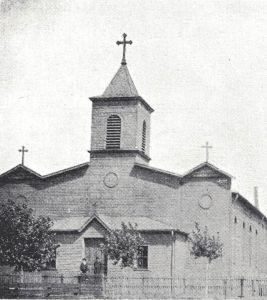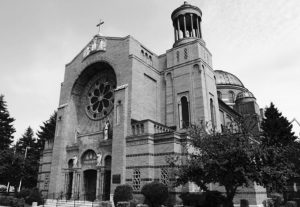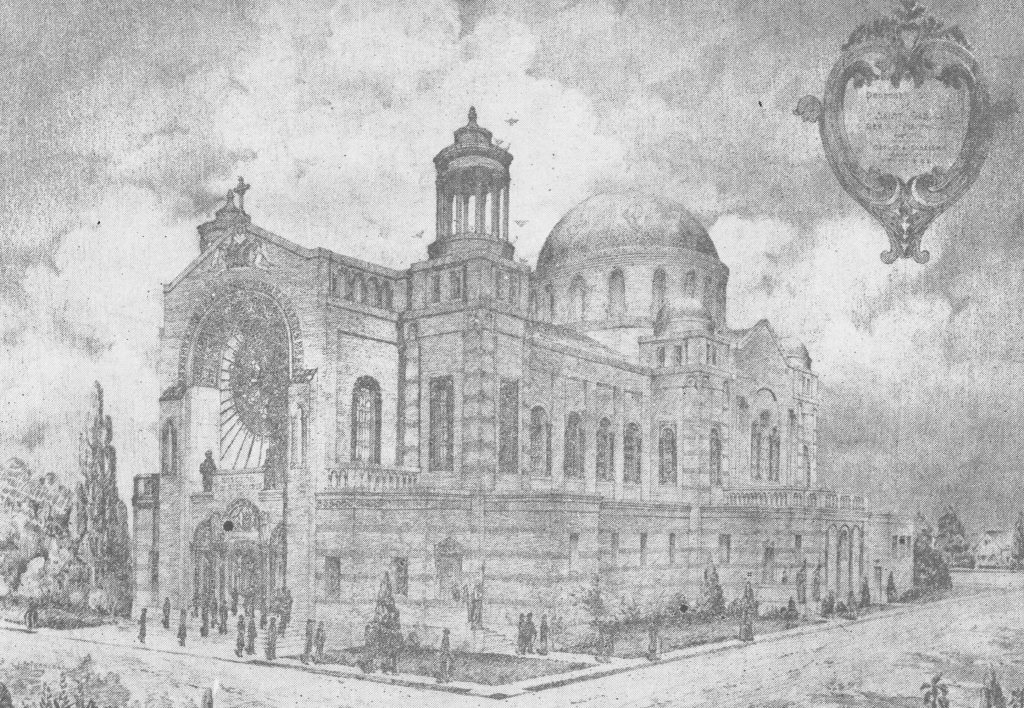The fourth Polish church in Buffalo, St. Casimir’s, would have a profound effect on not only the Poles, but the city, and the history of Catholicism in Western New York. In the late 1880s, Poles began settling near Clinton and South Ogden having found work in the area. In 1890, 40 Polish families petitioned the bishop to establish a church to meet their religious needs. The bishop agreed and on November 16, 1890, St. Casimir’s Church was dedicated on land donated by City Court Judge Daniel J. Kenefick. It would be from anglicization of the Polish name of the church, Kazimierzowo, that the neighborhood would become known as Kaisertown.
 The first church, a large wooden structure, colloquially known as Noah’s Ark, served as the church, school, and rectory. In its first 10 years the parish grew, despite a high turnover of priests with many of them commuting from St. Stanislaus. It was with the appointment of Father Kasprzak in 1900 that stability was brought to the now bustling church. In 1903, there were 1,200 parishioners with 93 students in the school and plans were soon begun to build a new parish building. The three-story, brick combination school and church structure was completed in 1908 at a cost of $78,000.
The first church, a large wooden structure, colloquially known as Noah’s Ark, served as the church, school, and rectory. In its first 10 years the parish grew, despite a high turnover of priests with many of them commuting from St. Stanislaus. It was with the appointment of Father Kasprzak in 1900 that stability was brought to the now bustling church. In 1903, there were 1,200 parishioners with 93 students in the school and plans were soon begun to build a new parish building. The three-story, brick combination school and church structure was completed in 1908 at a cost of $78,000.
Following Father Kasprzak, a number of priests served at St Casimir’s with two of them having a lasting impact on the area. Both Father Stabenau and Father Anthony Majewski worked to have the streets of Kaisertown paved, knowing that the growth of the area depended on it. Father Majewski would also be responsible for other street improvements and flood mitigation of the Buffalo River after a number of children drowned, but the priest’s lasting legacy would be a new church.
 In 1926, at the behest of the chancery, Father Anthony began looking into a new church building for St. Casimir’s. Inspired by the churches he saw in Europe, Majewski hired architect Chester Oakley to design a Byzantine-style church reminiscent of the Hagia Sophia in Istanbul, Turkey. A young Joseph E. Fronczak, then an associate architect with Oakley, was charged with much of the detailing of the building. The stained glass was imported from Mayer of Munich in Germany while Buffalo artist Joseph C. Mazur was hired to paint the murals. The total cost of the project was $450,000. Father Anthony Majewski guided the parish through the Great Depression and World War II until his death in 1955.
In 1926, at the behest of the chancery, Father Anthony began looking into a new church building for St. Casimir’s. Inspired by the churches he saw in Europe, Majewski hired architect Chester Oakley to design a Byzantine-style church reminiscent of the Hagia Sophia in Istanbul, Turkey. A young Joseph E. Fronczak, then an associate architect with Oakley, was charged with much of the detailing of the building. The stained glass was imported from Mayer of Munich in Germany while Buffalo artist Joseph C. Mazur was hired to paint the murals. The total cost of the project was $450,000. Father Anthony Majewski guided the parish through the Great Depression and World War II until his death in 1955.
One of the most important events in St. Casimir’s history occurred August 17, 1976, when future Pope and Saint, John Paul the Great celebrated a Mass in the church. Part of a tour of the United States with 17 Polish Bishops, the then Cardinal Wojtyla spent the night in the parish rectory, which in 2014 was made into a Papal Prayer Room in his honor.
In April of 2011, it was announced that St. Casimir’s would be made an oratory and merged into Lady of Czestochowa Parish in Cheektowaga. Father Czeslaw Krysa become the rector of St. Casimir’s and through his work, Bishop Kmiec decreed in July of 2012 that, “St. Casimir would no longer be an oratory; it is now a church of particular use, providing for the spiritual care of the faithful, particularly those of Polish descent.”

Do you have any stories or memories about this location of the Polonia Trail? We would love to hear it! Please send us your story, and if it is chosen, it will be added to the site.
Send Your Story“I had the honor and privilege of growing up in and serving at St.Casimir’s. Three generations of my family were deeply active in parish life. My grandfather was a custodian and my father served as President of the Ushers Society for 14 years. My family graduated from St. Casimir’s and my brother and I were alter boys and members of the CYO. My greatest memory was serving as alter boys to St. John Paul II. As president of the Ushers my father arranged a meeting with him personally. St. John Paul shook my hand and asked my name, which I answered in Polish. Then he laid his hands upon me and blessed me. Little was I aware of what has just happened.”
Thomas Durlak